
SNARING GAME
In case you're wondering why I don't call this page "deadfalls & snares" like some other survival sites do. It's because it's a hellova lot easier to learn how to make "snare traps" than deadfalls.
To make a “snare” you only need some wire, string or a shoelace and know how to tie a few simple knots and where to set'em to catch a critter. To make a "deadfall" you need an axe, saw and or a big ol'Rambo knife and lots of time to construct and prepare a deadfall trap. Why? Because they're made out of logs and or rocks and almost all of them require some type of bait to lure an animal inside or underneath a deadfall. Not to mention, you just about need an "engineer degree" to remember how to make'em because some of them are pretty damn complicated to build.
Learning how to make snares is easy, it's knowing where to set 'em to get results is the hard part. And instead of boring you with all the fine details of snaring, I'll just move along and cover the really important stuff, ok? |
|
As I stated above you can make snares from almost anything such as from the inner strands of 550 parachute cord, nylon dental floss, electrical wire and including from your boot laces too You can even make snare traps from some selected vines and weeds but..this is the least preferred method.
TIME OUT! If you're an experienced outdoorsman such as a trapper, hunter or a survivalist, I know what you're thinking ." What! You're not gonna catch anything with this stuff, an animal is gonna toss, turn, jerk, chew, and bust his way right out of it! "
Well it depends on what you're trying to catch. If you're trying to catch rabbits and squirrels, you know the small, plentiful and easyt-to-catch critters, they'll work just fine. Maybe not all the time, but most of the time. Of course if you're trying to catch something much larger and cautious like a raccoon, fox, woodchuck or a bear, you're right, none of this stuff is gonna hold any of these critters. Duh?
And awhile back I got into a debate with a professional trapper and a survival guru over which type of snares should be used and carried in a pocket survival kit. Which their argument was, "..it's better to carry 2 or 3 factory-made snares than a dozen snares made out of parachute cord or wire."
They're right! Factory-made snares are better, but are they feasible to carry in a survival kit and are 2 or 3 enough?
Well according to most survival instructors, both military and civilian. The ones I talked to all agreed that if you're an "experienced" hunter, trapper, or survivalist you can probably get away with carrying 2 or 3 snares in a survival kit because you know where to set'em to get results. But if you're NOT experienced, then you're gonna need a hellova lot more than a few snares if you want results, somewhere between 6 - 12 snare traps.
And so the bottom line is this….the more experience you have in trapping & snaring game, the less snares you'll need to pack and carry. But the less experience you have, the more snares you're gonna need. And if you're traveling light, on foot and carrying only a small pocket survival kit… Well you'll have much better luck catching something with 6 - 12 "home-made" snares than just 2 or 3 fancy factory-made snares. Figure it out, the formula's in the "math & experience." Duh?
Moving on...
And so once you have the material, all ya gotta do is make a "loop" and attach a "sliding knot" so when a critter sticks his head through it… it'll tighten up and either hold'em in place or choke his or her ass to death.
When preparing the material, don't try to make each snare the same length because the lengths will depend on where you (a) place the noose and (b) where you're gonna anchor or tie it. You do now understand that you're gonna have to make more than one snare, don't you? Why? Because the more you set out - the more chances you'll have in catching something to eat before you starve to death. Which is known among professional trappers as a "trap line," the laying out of a buncha traps.
Are you listening and paying attention to what I've written here? Again you're gonna need between 6 to 12 snare traps. PAY ATTENTION, damn it! Do you wanna catch something to eat or do you starve to death?
Now to figure out where to set these snares, look for "fresh" animal signs such as tracks in soft mud, droppings (poop, shit) on the ground, narrow trails with tromped up dirt, flattened grass, dug up vegetation, holes in trees, logs or in the ground, etc. Things that indicate critters are regularly visiting, passing by or living in the area.
Not to mention, wherever you find water you can bet they're drinking and hunting for food and other critters there too. And one of the best places to set snare traps is on both ends of a log lying across a creek or stream. Why? Because it's a natural bridge crossing for animals who don't wanna get their feet wet, and you'd be surprised in how many don't and use it quite often everyday too.
Critters are smart, not only do they have good eyesight and hearing, but they rely on their noses to tell'em when something ain't right. Or I should say, "don't smell right." And because we humans have a distinctive and strange odor, some more than others, phew! Before placing out snares you should try to cover up and mask your human scent by standing next to a fire for a few minutes and allowing the "smoke" to cover your entire body and your snare material too. And or at a distance away from the spot where you intend to place a snare, rub some dirt onto your hands to help mask & cover up your human scent.
And now the best part that you've been waiting for…"how to set snares and where."
Though they're much easier to make and set with wire, you should practice making'em out of all types of material just in case you don't have any wire to use. And just so you can see these snare traps a bit more clearly, I spray painted the wire/string "fluorescent orange" and made some parts a bit larger than they should be. Note: While some other survival sites & books my list'em as something else, I'm not renaming'em just calling'em how they're used.
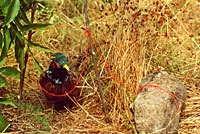 |
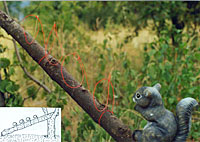 |
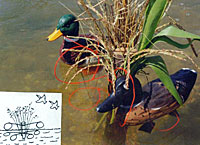 |
| Trail Snare Trap |
Log Snare Trap |
WaterFowl Snare Trap |
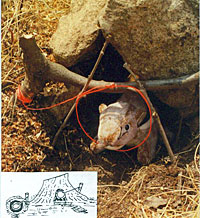 |
 |
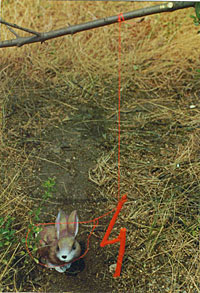 |
| Hole Snare Trap |
General Snares |
Spring Snare Trap |
IMPORTANT: Snare traps should be checked twice a day, preferably just before sunset and just after sunrise. But if you're using "weak and flimsy" material, then you need to check'em more often before a critter has time to work himself free and escape. And when you do, always check your snare traps a good distance away so you don't spook any animals that may be lurking nearby.
REALLY IMPORTANT: If the critter is still alive when caught, which he probably will be, find yourself a big, long, sturdy stick and give'em a good hard whack across the head to stun him. Then finish him off with a bunch of harder whacks until he stops moving, breathing, and you see blood flowing from his nose, ears and eyes.

